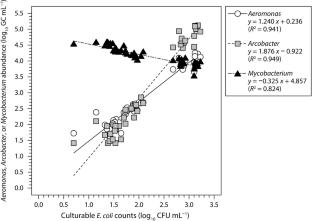Behavior of Aeromonas, Arcobacter, and Mycobacterium in freshwater microcosms polluted with domestic wastewater
Abstract
Understanding the behavior of pathogenic bacterial groups from domestic wastewater in surface water is critical to improving sanitation risk assessment and supporting effective policy implementation. Despite their importance, their behavior in freshwater environments is not fully understood. This study examined the behavior of pathogenic bacterial groups frequently found in domestic wastewater–Aeromonas, Arcobacter, and Mycobacterium—in freshwater microcosms containing domestic wastewater with different initial ammonium-nitrogen (NH4+-N) concentrations (2, 5, and 15 mg N L−1). Digital polymerase chain reaction (dPCR) assays with propidium monoazide (PMA) pretreatment were used to evaluate the behavior of viable targeted bacteria. Aeromonas and Arcobacter decayed quickly after the experiment began, with typical first-order decay constants of 0.718 to 0.820 day−1 and 1.14 to 1.19 day−1, respectively. These rates were comparable or higher than those of Escherichia coli, an indicator of fecal contamination (0.586–0.680 day−1). Conversely, the abundance of Mycobacterium increased over the course of the 7-day experiment. The decay or growth of the target bacterial groups in the microcosms under aerobic conditions was not affected by varying NH4+-N concentrations. Sequencing of the near-full-length 16S ribosomal ribonucleic acid (16S rRNA) gene amplicons with PMA pretreatment revealed that the primary Aeromonas and Arcobacter populations in the initial microcosms were pathogenic species relatives. Conversely, the major Mycobacterium populations thriving in the microcosms were presumably uncultured species with low 16S rRNA gene sequence similarity (< 98.65%) to the cultured species. This study provides insights to improve sanitation risk assessment and promote suitable policy implementation.


 求助内容:
求助内容: 应助结果提醒方式:
应助结果提醒方式:


